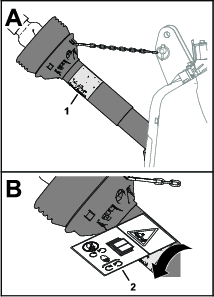| Maintenance Service Interval | Maintenance Procedure |
|---|---|
| After each use |
|
Introduction
This machine is intended to be used by professional, hired operators in commercial applications. It is designed primarily for working large areas on well-maintained lawns in parks, golf courses, sports fields, and on commercial grounds. Using this product for purposes other than its intended use could prove dangerous to you and bystanders.
Read this information carefully to learn how to operate and maintain your product properly and to avoid injury and product damage. You are responsible for operating the product properly and safely.
Visit www.Toro.com for product safety and operation training materials, accessory information, help finding a dealer, or to register your product.
Whenever you need service, genuine Toro parts, or additional information, contact an Authorized Service Dealer or Toro Customer Service and have the model and serial numbers of your product ready. Figure 1 and Figure 2 identify the location of the model and serial numbers on the product. Write the numbers in the space provided.
Important: With your mobile device, you can scan the QR code (if equipped) on the serial number plate to access warranty, parts, and other product information.
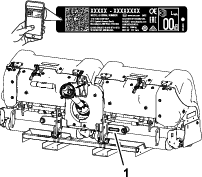
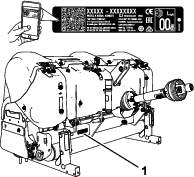
his manual identifies potential hazards and has safety messages identified by the safety-alert symbol (Figure 3), which signals a hazard that may cause serious injury or death if you do not follow the recommended precautions.

This manual uses 2 words to highlight information. Important calls attention to special mechanical information and Note emphasizes general information worthy of special attention.
This product complies with all relevant European directives; for details, please see the separate product specific Declaration of Conformity (DOC) sheet.
Warning
CALIFORNIA
Proposition 65 Warning
Use of this product may cause exposure to chemicals known to the State of California to cause cancer, birth defects, or other reproductive harm.
Safety
General Safety
This product is capable of amputating hands and feet and of throwing objects. Always follow all safety instructions to avoid serious personal injury.
Using this product for purposes other than its intended use could prove dangerous to you and bystanders.
-
Read and understand the contents of this Operator’s Manual before using the machine.
-
Use your full attention while operating the machine. Do not engage in any activity that causes distractions; otherwise, injury or property damage may occur.
-
Do not put your hands or feet near moving components of the machine.
-
Do not operate the machine without all guards and other safety protective devices in place and functioning properly on the machine.
-
Keep clear of any discharge opening. Keep bystanders and pets away from the machine.
-
Keep bystanders and children out of the operating area. Never allow children to operate the machine.
-
Always shut off the engine of the traction unit, remove the key (if equipped), wait for all moving parts to stop, and allow the machine to cool before adjusting, servicing, cleaning, or storing the machine.
Improperly using or maintaining this machine can result in injury.
To reduce the potential for injury, comply with these safety instructions
and always pay attention to the safety-alert symbol  , which means
Caution, Warning, or Danger—personal safety instruction. Failure
to comply with these instructions may result in personal injury or
death.
, which means
Caution, Warning, or Danger—personal safety instruction. Failure
to comply with these instructions may result in personal injury or
death.
Safety and Instructional Decals
 |
Safety decals and instructions are easily visible to the operator and are located near any area of potential danger. Replace any decal that is damaged or missing. |
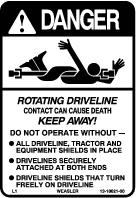
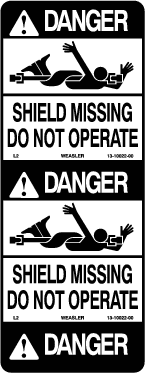





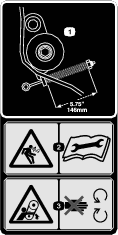






Setup
Inspecting the Machine
Checking the Traction Unit Requirements
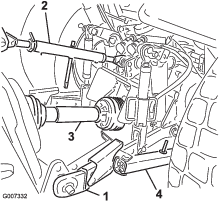
Use the following list as a reference:
-
Use a 30 PTO horsepower minimum when aerating in light to normal soil conditions (sandy to sandy/loam soils with average compaction).
-
Use a 35 PTO horsepower minimum when aerating in normal to heavy soil conditions (heavy loam, clay, and rocky soils with above average compaction).
-
The traction unit must have a category I or II 3-point hitch with a minimum implement lift capacity of 714 kg (1,575 lb).
-
The traction unit must have a PTO output-shaft speed of 540 rpm.
-
Adequate front-end weight (ballast) to offset the weight of the machine.
-
Check the tire air pressure of the traction unit.
Adjust the tire air pressure as needed.
Important: Do not exceed the maximum or minimum tire inflation pressures as recommended by tire manufacturer.
Checking the Traction Unit Requirements
Use the following list as a reference:
-
Use a 45 PTO horsepower minimum when aerating in light to normal soil conditions (sandy to sandy/loam soils with average compaction).
-
50 PTO horsepower minimum when aerating in normal to heavy soil conditions (heavy loam, clay, and rocky soils with above average compaction).
-
The traction unit must have a category II 3 point hitch with a minimum implement lift capacity of 1043 kg (2,300 lb) implement.
-
The traction unit must have a PTO output-shaft speed of 540 rpm.
-
Adequate front-end weight (ballast) to offset the weight of the machine.
-
Check the tire air pressure of the traction unit.
Adjust the tire air pressure as needed.
Important: Do not exceed the maximum or minimum tire inflation pressures as recommended by tire manufacturer.
Checking the Ballast Requirements
Warning
Mounting the machine to the rear of the traction unit decreases the weight on its front axle.
Failure to add required ballast may result in an accident and severe injury or death.
-
To ensure adequate steering control and stability you may need to add ballast to the front of the traction unit.
-
Refer to the traction unit operator's manual for ballast requirements.
Connecting the Lower Link Arms
Parts needed for this procedure:
| Lynch pin | 2 |
-
Ensure that the machine is positioned on a level surface for installation.
-
Ensure that the PTO is disengaged.
-
Back the traction unit squarely up to the machine until the lower link arms are aligned with the hitch pins.
-
Engage the parking brake, shut off the engine, and remove the key from the ignition. Wait for the engine and all moving parts to stop before leaving the operator's seat.
Note: For maximum ground clearance, install the hitch pins in the lower mounting holes of the hitch plate for the machine (Figure 5). To determine when to use the upper mounting holes, refer to setup procedure Connecting the PTO Driveshaft.
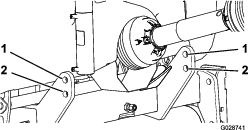
-
Insert the right and left lower link arms onto the hitch pins (Figure 6).

-
Secure the lower link arms to the hitch pins with the lynch pins (Figure 6).
Connecting the Upper Link
Parts needed for this procedure:
| Link pin | 1 |
| Lynch pin | 1 |
Note: For best aeration hole quality, align the front of the machine vertical while operating it (Figure 7). Adjust the upper link to control this angle. Refer to Operating Tips for additional information.
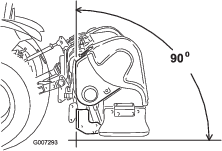
-
Connect the upper link to the lower hole in the bracket and secure it with the link pin and the lynch pin (Figure 8).
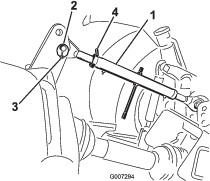
-
Grease the threaded steel upper link tubes.
-
Rotate the upper link to tighten the link. Adjust it until the frame at the front of the machine is vertical (Figure 8).
-
Tighten the locknut to secure the upper link into position.
Connecting the PTO Driveshaft
Parts needed for this procedure:
| Bolt (1/2 x 3 inches) | 1 |
| Nut (1/2 inch) | 1 |
| Short driveshaft, Part No. 115-2839 (may be needed; sold separately) | – |
Determining the Trailing Arm Length and PTO Driveshaft
Important: Refer to the PTO driveshaft owner’s manual for additional operating and safety information.
-
Place a straightedge across the ends of the trailing arms to help you determine the distance between them and the end of the PTO output shaft (Figure 9).
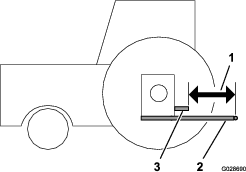
-
Measure the distance between the end of the PTO output shaft and the attachment point of the lower trailing arms (Figure 9). Record your measurement here:
Important: Contact your authorized Toro distributor if you need any assistance when performing this measurement and if you need to order an optional shorter PTO driveshaft assembly.
-
Determine whether you need a standard length PTO driveshaft or a short PTO driveshaft from the position of the PTO output shaft on the traction unit, relative to the position of the lower trailing arms. This distance is designated as “M” dimension.
-
The standard PTO driveshaft included with your machine fits a traction unit “M” dimension as small as 48.89 cm (19.25 inches).
-
If the “M” dimension is smaller, we offer an optional short PTO driveshaft assembly, which fits a traction unit “M” dimension as small as 39.37 cm (15.50 inches); refer to the Parts Catalog for your machine.
Important: If necessary, install the short driveshaft, Part No. 115-2839 (sold separately). In most cases, the short driveshaft is not needed.
-
-
If your traction unit is equipped with adjustable trailing arms, change the length of trailing arms until the “M” dimension measures:
Refer to the operator's manual for your traction unit.
-
48.89 cm (19.25 inches) or longer for the standard PTO shaft
-
39.37 cm (15.50 inches) or longer for the optional short PTO shaft
-
Installing the PTO Driveshaft
Caution
Operating the machine without the PTO guards and shields may cause injury or death.
-
Keep all PTO guards and shields in place.
-
On CE models, connect the chains between the PTO driveshaft guards and the link arms.
-
On the ProCore 864 only, remove the lower PTO shield (Figure 10).
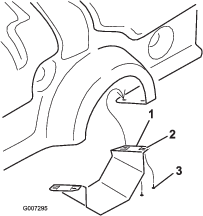
-
Assemble the PTO driveshaft to the gearbox input shaft of the machine (Figure 11) with a bolt (1/2 x 3.00 inches) and a nut (1/2 inch).
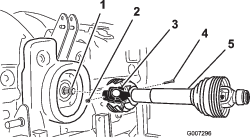
-
Assemble the PTO driveshaft to the PTO output shaft of the traction unit.
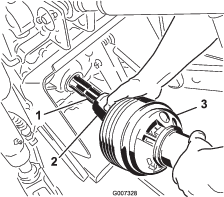
-
Slide the PTO driveshaft forward as far as the PTO output shaft allows.
-
Pull back on the locking collar of the PTO shaft coupler to secure the PTO driveshaft. Slide the PTO driveshaft back and forth to ensure that it is locked securely.
-
On CE models only, connect the safety chains from the driveshaft guards to the welded clips on the link arms. Make sure that the chains remain slack when the machine is raised or lowered.
-
On the ProCore 864, install the lower PTO shield to the machine.
-
Verify that the telescoping tube has a minimum of 76 mm (3 inches) overlap when the machine is raised to the maximum height.
To check the overlap, measure the distance between the end shields, as shown in Figure 13. This dimension must not exceed 406 mm (16 inches). If so, move the lower lift pins to the upper set of holes before operating the machine.

Adjusting the Sway Links
-
The ProCore 864 is designed to be offset from the traction unit center line. The gearbox input shaft is offset 40 mm (1.57 inches) to the left of center and the machine is offset 145 mm (5.70 inches) to the right of the center line. Adjust the sway links as needed.
-
The ProCore 1298 is designed to be centered with the traction unit center line. Adjust the sway links as needed.
Adjust the sway links on the lower draft arms of the 3 point hitch to resist side-to-side sway to a maximum of 25 mm (1 inch) at each side (Figure 14).

Adjust the lower links inboard until they contact the machine mounting plates. This reduces stress on the pins. If the traction unit has sway chains instead of sway links, install washers between the lower link arm and lynch pin to reduce the overhung load on the lift pins.
Note: Refer to the traction unit operator's manual for additional installation and adjustment procedures.
Leveling the Machine Side-to-Side
-
Park the traction unit and the machine on a level, firm surface.
-
Place a level on top of the frame of the machine to check it for level side-to-side (Figure 15).
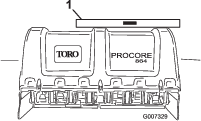
-
If provided, turn the adjustable link body to raise or lower the link arm until the machine is leveled side-to-side.
Note: Refer to the traction unit operator's manual for additional adjustment procedures.
Adjusting the Roller Scraper
Adjust the roller scraper so that there is a gap of approximately a 1 to 2 mm (0.06 to 0.09 inch) between the scraper and the roller.
-
Loosen the fasteners securing each end of scraper to roller scraper tab (Figure 16).
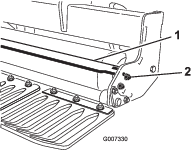
-
Slide the roller scraper in or out until the required position is attained, and tighten the fasteners.
-
On the ProCore 864 only, you can adjust the stop bolt on the center support to attain the proper gap.
Installing the Tine Heads and the Tines
A wide selection of tines and tine heads are available for the machine. Choose the tine type, size, and spacings required for the job. Install the tine head and tines per the Installation Instructions supplied with each tine kit; refer to ProCore 864 tine configuration table and ProCore 1298 tine configuration table in Attachments/Accessories.
Important: Never operate the machine without the tine heads installed. The arms may move excessively and damage the frame of the machine.
Installing the Turf Guards
Parts needed for this procedure:
| Turf guards (not included) | – |
A wide selection of turf guards is available for the machine. Use the appropriate turf guards for the selected tine heads.
-
Loosen the nuts securing the turf guard clamps to the turf guard tool bar (Figure 17).
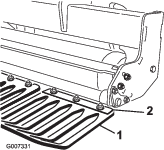
-
Slide the appropriate turf guard under the turf guard clamp.
-
Adjust the turf guards, left to right, to maintain equal distance to the tines within each slot.
-
Tighten the nuts securing the turf guard.
-
Mount the remaining turf guards and secure the turf guard clamps.
Important: From the rear of the machine, check that the tines line up with the center of the gaps in the turf guards.
Securing the Hood Latches (CE only)
Parts needed for this procedure:
| CE Compliance Kit, Part No. 110-4693 (not included) | 1 |
Note: The CE Completion Kit, Part No. 110-4693 is required to complete this step.
-
On the ProCore 864 model, install a lock bracket over the left and right rear lower hood and upper hood latches with a tap bolt (4 total); refer to Figure 18.
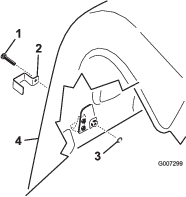
-
On the ProCore 1298 model, install a lock bracket over all the rear lower hood latches and the outside upper hood latch on both the right and the left rear covers with a tap bolt (3 per coring head, 6 total); refer to Figure 18).
-
Using a pliers or adjustable wrench, thread an internal lock washer onto each bolt (1 to 2 threads) to secure the latch (Figure 18).
Applying the Entanglement Decal
Parts needed for this procedure:
| CE entanglement decal | 4 |
Important: This procedure is required for all CE countries and anywhere English is not commonly spoken.
Removing the Storage Stands
Parts needed for this procedure:
| Lynch pin (ProCore 864) | 4 |
Removing the Stands
Important: Use the storage stand whenever you remove the machine from the traction unit.
-
Start the traction unit, raise the machine 7.6 to 15.2 cm (3 to 6 inches) off the ground, shut off the engine and remove the key.
-
Remove the 2 lynch pins securing the storage stand to the stand bracket on the hitch frame of the machine (Figure 20).
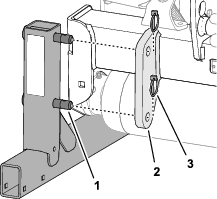
-
Remove the storage stand.
-
Repeat steps 2 and 3 at the other side of the machine.
-
Insert the lynch pins (included in loose parts) into the stand pins for storage (Figure 20).
Removing the Stand
Important: Use the storage stand whenever you remove the machine from the traction unit.
Note: The storage stand weighs approximately 85 kg (187 lb).
-
Start the traction unit, raise the machine off the ground slightly, shut off the engine and remove the key.
-
Remove the 2 hairpins that secure the 2 storage-stand pins to the storage stand (Figure 21).
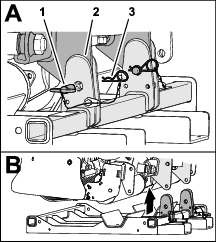
-
Remove the 2 storage stand pins (Figure 21).
-
Start the traction unit, and use it to lift the machine from the storage stand.
Product Overview
Depth Adjuster
Rotate the depth adjuster input shaft clockwise to reduce the aeration depth or counterclockwise to increase the aeration depth (Figure 22).
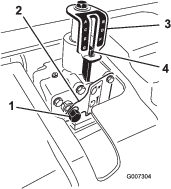
Note: 17 revolutions of the depth adjuster equal approximately 6.4 mm (1/4 inch) depth change.
Note: Specifications and design are subject to change without notice.
| Working Width | 163 cm (64 inches) |
| Overall Width | 170 cm (67 inches) |
| Overall Length | 89 cm (35 inches) |
| Overall Height | 98 cm (38.5 inches) |
| Weight | 714 kg (1,575 lb) |
| Working Width | 249 cm (98 inches) |
| Overall Width | 257 cm (101 inches) |
| Overall Length | 89 cm (35 inches) |
| Overall Height | 98 cm (38.5 inches) |
| Weight | 1043 kg (2,300 lb) |
Attachments/Accessories
A selection of Toro approved attachments and accessories is available for use with the machine to enhance and expand its capabilities. Contact your Authorized Service Dealer or authorized Toro distributor or go to www.Toro.com for a list of all approved attachments and accessories.
To ensure optimum performance and continued safety certification of the machine, use only genuine Toro replacement parts and accessories. Replacement parts and accessories made by other manufacturers could be dangerous, and such use could void the product warranty.
| Tine Kit Description | Needle Tine | Quad Tine (2x5) | Quad Tine (1x6) | ||||||
|---|---|---|---|---|---|---|---|---|---|
| Model No. | 09739 | 09736 | 09737 | ||||||
| Kit Qty. | 4 | 4 | 4 | ||||||
| Tines Required | 40 | 80 | 48 | ||||||
| Lateral Spacing | 40 mm (1.6 inches) | 40 mm (1.6 inches) | 33 mm (1.3 inches) | ||||||
| Mount | 5 mm and 8 mm | 10 mm (3/8 inch) diameter | 10 mm (3/8 inch) diameter | ||||||
| Turf Guard Part No. | 120-1047 | 120–1061 | 120-1062 | 120-1047 | 120-1061 | 120-1062 | 120-1050 | 120-1063 | 120-1064 |
| Required Qty. | 2 | 1 | 1 | 2 | 1 | 1 | 2 | 1 | 1 |
| Tine Options | 5 mm and 8 mm Needles | Titan and Titan Quad; Titan and Titan Max Cross; Titan Solid Round | Titan and Titan Quad; Titan and Titan Max Cross; Titan Solid Round | ||||||
| Tine Kit Description | 3-Tine | 4-Tine | 3-Tine HD | ||||||
|---|---|---|---|---|---|---|---|---|---|
| Model No. | 09794 | 09796 | 09797 | ||||||
| Kit Qty. | 4 | 4 | 4 | ||||||
| Tines Required | 24 | 32 | 24 | ||||||
| Lateral Spacing | 66 mm (2.6 inches) | 51 mm (2.0 inches) | 66 mm (2.6 inches) | ||||||
| Mount | 19 mm (3/4 inch) diameter | 19 mm (3/4 inch) diameter | 22 mm (7/8 inch) diameter | ||||||
| Turf Guard Part No. | 120-1044 | 120-1057 | 120-1058 | 120-1045 | 120-1059 | 120-1060 | 120-1044 | 120-1057 | 120-1058 |
| Required Qty. | 2 | 1 | 1 | 2 | 1 | 1 | 2 | 1 | 1 |
| Tine Options | Titan Hollow and Max Hollow; Titan Side Eject and Max Side Eject | Titan Hollow and Max Hollow; Titan Side Eject and Max Side Eject | Titan Hollow and Max Hollow; Titan Side Eject and Max Side Eject | ||||||
| Titan Cross and Max Cross*; Titan Slicing; Titan Fairway and HD Fairway Titan Split; Titan Solid Round | Titan Cross and Max Cross*; Titan Slicing; Titan Fairway and HD Fairway Titan Split; Titan Solid Round | Titan Cross and Max Cross*; Titan Slicing; Titan Fairway and HD Fairway Titan Split; Titan Solid Round | |||||||
| Tine Kit Description | Quick Change (3-Tine) | Quick Change (4-Tine) | ||||||
|---|---|---|---|---|---|---|---|---|
| Model No. | 09711 | 09719 | ||||||
| Kit Qty. | 4 | 4 | ||||||
| Tines Required | 24 | 32 | ||||||
| Lateral Spacing | 66 mm (2.6 inches) | 51 mm (2.0 inches) | ||||||
| Mount | Not Applicable | Not Applicable | ||||||
| Sleeve Description | 19 mm (3/4 inch) | 122 mm (7/8 inch) | 19 mm (3/4 inch) | 22 mm (7/8 inch) | ||||
| Part No. | 108-6837 | 108-6838 | 108-6837 | 108-6838 | ||||
| Required Qty. | 24 | 24 | 32 | 32 | ||||
| Tool Kit Part No. (1 required) | 114-0890-01 | 114-0890-01 | ||||||
| Turf Guard Part No. | 120-1044 | 120-1057 | 120-1058 | 120-1045 | 120–1059 | 120-1060 | ||
| Required Qty. | 2 | 1 | 1 | 2 | 1 | 1 | ||
| Tine Options | Titan Hollow and Max Hollow; Titan Side Eject and Max Side Eject | Titan Hollow and Max Hollow; Titan Side Eject and Max Side Eject | ||||||
| Titan Cross and Max Cross*; Titan Slicing; Titan Fairway and HD Fairway Titan Split; Titan Solid Round | Titan Cross and Max Cross*; Titan Slicing; Titan Fairway and HD Fairway Titan Split; Titan Solid Round | |||||||
| Tine Kit Description | Needle Tine | Quad Tine (2x5) | Quad Tine (1x6) | 3-Tine | ||||
|---|---|---|---|---|---|---|---|---|
| Model No. | 09739 | 09736 | 09737 | 09794 | ||||
| Kit Qty. | 6 | 6 | 6 | 6 | ||||
| Tines Required | 60 | 120 | 72 | 36 | ||||
| Lateral Spacing | 40 mm (1.6 inches) | 40 mm (1.6 inches) | 33 mm (1.3 inches) | 66 mm (2.6 inches) | ||||
| Mount | 5 mm and 8 mm | 10 mm (3/8 inch) diameter | 10 mm (3/8 inch) diameter | 19 mm (3/4 inch) diameter | ||||
| Turf Guard Part No. | 120-1047 | 120-1052 | 120-1047 | 120-1052 | 120-1050 | 120-1053 | 120-1044 | 120-1051 |
| Required Qty. | 4 | 2 | 4 | 2 | 4 | 2 | 4 | 2 |
| Tine Options | 5 mm and 8 mm Needles | Titan and Titan Quad; Titan and Titan Max Cross; Titan Solid Round | Titan and Titan Quad; Titan and Titan Max Cross; Titan Solid Round | Titan Hollow and Max Hollow; Titan Side Eject and Max Side Eject | ||||
| Titan Cross and Max Cross*; Titan Slicing; Titan Fairway and HD Fairway Titan Split; Titan Solid Round | ||||||||
| Tine Kit Description | 4-Tine | 3-Tine HD | Quick Change (3-Tine) | Quick Change (4-Tine) | ||||
|---|---|---|---|---|---|---|---|---|
| Model No. | 09796 | 09797 | 09711 | 09719 | ||||
| Kit Qty. | 6 | 6 | 6 | 6 | ||||
| Tines Required | 48 | 36 | 36 | 48 | ||||
| Lateral Spacing | 51 mm (2.0 inches) | 66 mm (2.6 inches) | 66 mm (2.6 inches) | 51 mm (2.0 inches) | ||||
| Mount | 19 mm (3/4 inch) diameter | 22 mm (7/8 inch) diameter | Not Applicable | Not Applicable | ||||
| Sleeve Description | Not Applicable | Not Applicable | 19 mm (3/4 inch) | 22 mm (7/8 inch) | 19 mm (3/4 inch) | 22 mm (7/8 inch) | ||
| Part No. | 108-6837 | 108-6838 | 108-6837 | 108-6838 | ||||
| Required Qty. | 36 | 36 | 48 | 48 | ||||
| Tool Kit Part No. (1 required) | Not Applicable | Not Applicable | 114-0890-01 | 114-0890-01 | ||||
| Turf Guard Part No. | 120-1045 | 120-1046 | 120-1044 | 120-1051 | 120-1044 | 120-1051 | 120-1045 | 120-1046 |
| Qty. (required) | 4 | 2 | 4 | 2 | 4 | 2 | 4 | 2 |
| Tine Options | Titan Hollow and Max Hollow; Titan Side Eject and Max Side Eject | Titan Hollow and Max Hollow; Titan Side Eject and Max Side Eject | Titan Hollow and Max Hollow; Titan Side Eject and Max Side Eject | Titan Hollow and Max Hollow; Titan Side Eject and Max Side Eject | ||||
| Titan Cross and Max Cross*; Titan Slicing; Titan Fairway and HD Fairway Titan Split; Titan Solid Round | Titan Cross and Max Cross*; Titan Slicing; Titan Fairway and HD Fairway Titan Split; Titan Solid Round | Titan Cross and Max Cross*; Titan Slicing; Titan Fairway and HD Fairway Titan Split; Titan Solid Round | Titan Cross and Max Cross*; Titan Slicing; Titan Fairway and HD Fairway Titan Split; Titan Solid Round | |||||
Operation
Note: Determine the left and right sides of the machine from the normal operating position.
Before Operation
Before Operation Safety
General Safety
-
Never allow children or untrained people to operate or service the machine. Local regulations may restrict the age of the operator. The owner is responsible for training all operators and mechanics.
-
Become familiar with the safe operation of the equipment, operator controls, and safety signs.
-
Always shut off the engine of the traction unit, remove the key, wait for all moving parts to stop, and allow the machine to cool before adjusting, servicing, cleaning, or storing the machine.
-
Know how to stop the machine and shut off the engine quickly.
-
Do not operate the machine without all guards and other safety protective devices in place and functioning properly on the machine.
-
Before operating, always inspect the machine to ensure that the tines are in good working condition. Replace worn or damaged tines.
-
Inspect the area where you will use the machine and remove all objects that the machine could strike.
-
Locate and mark all electrical or communication lines, irrigation components, and other obstructions in the area to be aerated. Remove the hazards, if possible, or plan how to avoid them.
-
Ensure that your traction unit is suitable for use with a machine of this weight. Check with your traction unit supplier or manufacturer.
Outcross Traction Unit Controls
Refer to the Outcross traction unit Operator’s Manual for information on controls and operation, as well as additional information on setting up the machine.
Adjusting the Aeration Depth
Important: Adjust the aeration depth only when the traction unit is parked, the parking brake is engaged, the PTO is disengaged, and the engine is shut off.
-
Lay the desired tine onto the depth decal while aligning the tine tip with the desired aeration depth as shown in Figure 23.

-
Determine the letter setting aligned with the mounting end of the tine (Figure 23). Adjust the depth control to the corresponding letter on the decal.
-
Insert a 9/16-inch socket with a ratchet onto the depth adjuster input shaft (Figure 24).

-
Push in on the socket or use your hand to press on the locking plate.
-
Rotate the depth adjuster clockwise to reduce the aeration depth or counterclockwise to increase the aeration depth. (Figure 24).
-
Rotate the depth adjuster input shaft until the desired depth is attained as shown on the depth indicator decal (Figure 24).
Note: 17 revolutions of the depth adjuster input shaft equal approximately 6.4 mm (1/4 inch) depth change.
Understanding the Traction Unit Controls
Familiarize yourself with the operation of the following traction unit controls before operating the machine:
-
PTO engagement
-
3 point hitch (raise/lower)
-
Clutch
-
Throttle
-
Gear selection
-
Parking brake
Important: Refer to the traction unit operator's manual for operating instructions.
Understanding the Principles of Operation
The 3-point hitch linkage of the traction unit lifts the machine for transport and lowers it for operation.
Power from the traction unit power take-off (PTO) is transmitted through driveshafts, a gearbox, and drive belts to a crankshaft assembly, which drive the tine holding arms into the turf surface.
As the traction unit travels forward with the PTO engaged and the machine lowered, a series of holes are created in the turf.
The penetration depth of the tines is determined by the height of the depth control.
The distance between the aeration holes is determined by the gear ratio (or hydrostatic traction pedal position) of the traction unit and the number of tines in each tine head.
Note: Changing the engine speed does not change hole spacing.
Practicing the Operating Procedures
Important: When connecting the PTO, ensure that the machine is not lifted higher than is necessary. Lifting the machine too high causes the PTO driveshaft knuckles to break (Figure 25). The PTO can operate up to an angle of 25°, but can never exceed a 35° angle when the machine is at its highest position, or severe shaft damage may occur.
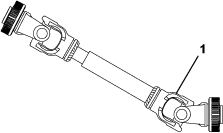
Before using the machine, find a clear area and practice operating the traction unit with the machine installed.
Important: If there are sprinkler heads, electrical or communication lines, or other obstructions in the area being aerated, mark these locations to ensure that these items are not damaged during operation.
-
Operate the traction unit using the recommended gear settings and PTO drive speeds and become thoroughly familiar with the traction unit handling with the attached machine.
-
Practice stopping and starting, raising the machine, and lowering the machine, disengaging the PTO drive, and aligning the machine with previous passes.
Practice sessions helps you gain confidence in the performance of the machine and helps ensure that you are using it properly.
Warning
Adjusting or maintaining the machine while the traction unit is running may result in an accident and severe injury or death
-
Before leaving the operator’s seat, disengage the PTO drive, engage the parking brake, shut off the engine, remove the key, and wait for all moving parts to stop.
-
Lower the machine onto the storage stands or appropriate blocking or jacks repairing the machine.
-
Ensure that all safety devices are secured in proper place before resuming operation.
Preparing to Aerate
Inspect the area of operation for hazards that could damage the machine and remove them, if possible, or plan how to avoid them. Carry replacement tines and tools in case tines are damaged due to contact with foreign materials.
During Operation
During Operation Safety
General Safety
-
The owner/operator can prevent and is responsible for accidents that may cause personal injury or property damage.
-
Do not operate the machine when tired, ill, or under the influence of alcohol or drugs.
-
Use your full attention while operating the machine. Do not engage in any activity that causes distractions; otherwise, injury or property damage may occur.
-
Wear appropriate clothing, including eye protection; slip-resistant, substantial footwear; long pants; and hearing protection. Tie back long hair and do not wear loose clothing or loose jewelry.
-
Never carry passengers on the machine and keep bystanders and pets away from the machine during operation.
-
Operate the machine only in good visibility to avoid holes or hidden hazards.
-
Keep your hands and feet away from the tines.
-
Look behind and down before backing up to be sure of a clear path.
-
Stop the machine, shut off the engine, wait for all moving parts to stop, and inspect the tines after striking an object or if there is an abnormal vibration in the machine. Make all necessary repairs before resuming operation.
-
The machine is heavy. When attached to a traction unit and in the raised position, its weight affects stability, braking and steering. Exercise caution when transporting between working areas.
-
Always maintain proper traction unit tire pressure.
-
Ensure that you comply with all regulations before transporting equipment on the public roads and highways. Make sure that all required reflectors and lights are in place and are clean and visible by overtaking and oncoming traffic.
-
Reduce speed on rough roads and surfaces
-
Independent wheel brakes should always be locked together when transporting.
-
Operate the machine only in good visibility. Do not operate the machine when there is the risk of lightning.
-
For all PTO driveshaft steel parts (tubes, bearings, joints, etc.) disassembly or repairs, it is highly advisable to contact your local Toro distributor. Removal of components for repairs and reassembly may damage some parts if not performed with special tools by trained technicians.
-
The PTO driveshaft must not be used without the guards supplied.
-
Friction clutches may become hot during use. Do not touch. To avoid the risk of fire, keep the area around the clutch free of flammable material and avoid prolonged slipping of the clutch.
Slope Safety
-
Review the traction unit specifications to ensure that you do not exceed its slope capabilities.
-
Slopes are a major factor related to loss of control and rollover accidents, which can result in severe injury or death. You are responsible for safe slope operation. Operating the machine on any slope requires extra caution.
-
Evaluate the site conditions to determine if the slope is safe for machine operation, including surveying the site. Always use common sense and good judgment when performing this survey.
-
Review the slope instructions listed below for operating the machine on slopes and review the conditions to determine whether you can operate the machine in the conditions on that day and at that site. Changes in the terrain can result in a change in slope operation for the machine.
-
Avoid starting, stopping, or turning the machine on slopes. Avoid making sudden changes in speed or direction. Make turns slowly and gradually.
-
Do not operate a machine under any conditions where traction, steering, or stability is in question.
-
Remove or mark obstructions such as ditches, holes, ruts, bumps, rocks, or other hidden hazards. Tall grass can hide obstructions. Uneven terrain could overturn the machine.
-
Be aware that operating the machine on wet grass, across slopes, or downhill may cause the machine to lose traction. Loss of traction to the drive wheels may result in sliding and a loss of braking and steering.
-
Use extreme caution when operating the machine near drop offs, ditches, embankments, water hazards, or other hazards. The machine could suddenly roll over if a wheel goes over the edge or the edge caves in. Establish a safety area between the machine and any hazard.
Operating the Machine
Note: When using needle tine heads, make sure to read the instructions included with the kit for unique operating procedures.
-
Lower the machine on the 3 point linkage so that the tines are nearly to the ground at the lowest part of their stroke.
-
At a low engine rpm, engage the power take off (PTO) clutch to start the machine.
Important: Never operate the machine without the tine heads installed.
-
Select a gear that gives a forward speed of approximately 1 to 4 km/h (0.6 to 2.5 mph) at the rated PTO speed of 540 rpm (refer to the traction unit operator's manual).
-
As the clutch is released and the traction unit moves forward, lower the machine fully into the turf and increase engine speed to give a maximum of 540 rpm at the PTO.
Important: Never operate the traction unit PTO faster than 540 rpm or you may damage to the machine.
Note: Make sure that the roller is on the ground.
-
Note the hole pattern. If you require greater hole spacing, increase forward the speed of the traction unit by shifting up a gear or with a hydrostatic drive traction unit, actuate the hydrostat lever or pedal to give faster speed. For closer hole spacing, decrease traction unit forward speed. Changing engine speed in a particular gear does not change the hole pattern.
Important: Look backward frequently to ensure that the machine is operating properly and alignment is maintained with previous passes.
-
Use the front traction unit wheel as a guide to maintain equal lateral hole spacing with the previous pass.
-
At the end of the aeration pass, raise the machine and disengage the PTO.
-
If you back into a tight area (like a tee box), disengage the PTO and raise the machine to the highest position. Use caution not to catch the turf guards on the turf.
-
Always clear the area of all damaged machine parts, such as broken tines, etc., to prevent anything from being picked up and thrown by mowers or other turf maintenance equipment.
-
Replace broken tines; inspect and repair damaged tines that are serviceable. Repair any other machine damage before operation.
Adjusting the Hole Spacing
The forward hole spacing is determined by the traction unit gear ratio (or the hydrostatic traction pedal). Changing the engine speed does not change the forward hole spacing.
The lateral hole spacing is determined by the number of tines in the tine heads.
| Hole spacing | Ground speed | ||||||||||||
|---|---|---|---|---|---|---|---|---|---|---|---|---|---|
| mm (inch) | km/h (mph) | ||||||||||||
| 25 (1) | 0.6 (0.4) | 0.6 (0.4) | 0.6 (0.4) | 0.6 (0.4) | 0.6 (0.4) | 0.6 (0.4) | 0.6 (0.4) | 0.6 (0.4) | 0.8 (0.5) | 0.8 (0.5) | 0.8 (0.5) | 0.8 (0.5) | 0.8 (0.5) |
| 32 (1.25) | 0.8 (0.5) | 0.8 (0.5) | 0.8 (0.5) | 0.8 (0.5) | 0.8 (0.5) | 0.8 (0.5) | 0.8 (0.5) | 1.0 (0.6) | 1.0 (0.6) | 1.0 (0.6) | 1.0 (0.6) | 1.0 (0.6) | 1.0 (0.6) |
| 38 (1.5) | 1.0 (0.6) | 1.0 (0.6) | 1.0 (0.6) | 1.0 (0.6) | 1.0 (0.6) | 1.0 (0.6) | 1.1 (0.7) | 1.1 (0.7) | 1.1 (0.7) | 1.1 (0.7) | 1.1 (0.7) | 1.1 (0.7) | 1.1 (0.7) |
| 44 (1.75) | 1.1 (0.7) | 1.1 (0.7) | 1.1 (0.7) | 1.1 (0.7) | 1.1 (0.7) | 1.1 (0.7) | 1.3 (0.8) | 1.3 (0.8) | 1.3 (0.8) | 1.3 (0.8) | 1.3 (0.8) | 1.3 (0.8) | 1.3 (0.8) |
| 51 (2) | 1.3 (0.8) | 1.3 (0.8) | 1.3 (0.8) | 1.3 (0.8) | 1.3 (0.8) | 1.4 (0.9) | 1.4 (0.9) | 1.4 (0.9) | 1.4 (0.9) | 1.4 (0.9) | 1.4 (0.9) | 1.6 (1.0) | 1.6 (1.0) |
| 57 (2.25) | 1.4 (0.9) | 1.4 (0.9) | 1.4 (0.9) | 1.4 (0.9) | 1.4 (0.9) | 1.6 (1.0) | 1.6 (1.0) | 1.6 (1.0) | 1.6 (1.0) | 1.6 (1.0) | 1.8 (1.1) | 1.8 (1.1) | 1.8 (1.1) |
| 64 (2.5) | 1.6 (1.0) | 1.6 (1.0) | 1.6 (1.0) | 1.6 (1.0) | 1.6 (1.0) | 1.8 (1.1) | 1.8 (1.1) | 1.8 (1.1) | 1.8 (1.1) | 1.9 (1.2) | 1.9 (1.2) | 1.9 (1.2) | 1.9 (1.2) |
| 70 (2.75) | 1.6 (1.0) | 1.8 (1.1) | 1.8 (1.1) | 1.8 (1.1) | 1.8 (1.1) | 1.9 (1.2) | 1.9 (1.2) | 1.9 (1.2) | 1.9 (1.2) | 2.1 (1.3) | 2.1 (1.3) | 2.1 (1.3) | 2.1 (1.3) |
| 76 (3) | 1.8 (1.1) | 1.9 (1.2) | 1.9 (1.2) | 1.9 (1.2) | 2.1 (1.3) | 2.1 (1.3) | 2.1 (1.3) | 2.1 (1.3) | 2.3 (1.4) | 2.3 (1.4) | 2.3 (1.4) | 2.3 (1.4) | 2.4 (1.5) |
| 83 (3.25) | 1.9 (1.2) | 2.1 (1.3) | 2.1 (1.3) | 2.1 (1.3) | 2.3 (1.4) | 2.3 (1.4) | 2.3 (1.4) | 2.3 (1.4) | 2.4 (1.5) | 2.4 (1.5) | 2.4 (1.5) | 2.6 (1.6) | 2.6 (1.6) |
| 89 (3.5) | 2.1 (1.3) | 2.3 (1.4) | 2.3 (1.4) | 2.3 (1.4) | 2.4 (1.5) | 2.4 (1.5) | 2.4 (1.5) | 2.6 (1.6) | 2.6 (1.6) | 2.6 (1.6) | 2.7 (1.7) | 2.7 (1.7) | 2.7 (1.7) |
| 95 (3.75) | 2.3 (1.4) | 2.4 (1.5) | 2.4 (1.5) | 2.4 (1.5) | 2.6 (1.6) | 2.6 (1.6) | 2.6 (1.6) | 2.7 (1.7) | 2.7 (1.7) | 2.7 (1.7) | 2.9 (1.8) | 2.9 (1.8) | 3.1 (1.9) |
| 102 (4) | 2.4 (1.5) | 2.6 (1.6) | 2.6 (1.6) | 2.6 (1.6) | 2.7 (1.7) | 2.7 (1.7) | 2.7 (1.7) | 2.9 (1.8) | 2.9 (1.8) | 3.1 (1.9) | 3.1 (1.9) | 3.1 (1.9) | 3.2 (2.0) |
| 108 (4.25) | 2.6 (1.6) | 2.7 (1.7) | 2.7 (1.7) | 2.7 (1.7) | 2.9 (1.8) | 2.9 (1.8) | 3.1 (1.9) | 3.1 (1.9) | 3.1 (1.9) | 3.2 (2.0) | 3.2 (2.0) | 3.2 (2.0) | 3.4 (2.1) |
| 114 (4.5) | 2.7 (1.7) | 2.9 (1.8) | 2.9 (1.8) | 2.9 (1.8) | 3.1 (1.9) | 3.1 (1.9) | 3.2 (2.0) | 3.2 (2.0) | 3.2 (2.0) | 3.4 (2.1) | 3.4 (2.1) | 3.5 (2.2) | 3.5 (2.2) |
| 121 (4.75) | 2.9 (1.8) | 3.1 (1.9) | 3.1 (1.9) | 3.1 (1.9) | 3.2 (2.0) | 3.2 (2.0) | 3.4 (2.1) | 3.4 (2.1) | 3.5 (2.2) | 3.5 (2.2) | 3.5 (2.2) | 3.7 (2.3) | 3.7 (2.3) |
| 127 (5) | 3.1 (1.9) | 3.2 (2.0) | 3.2 (2.0) | 3.2 (2.0) | 3.4 (2.1) | 3.4 (2.1) | 3.5 (2.2) | 3.5 (2.2) | 3.7 (2.3) | 3.7 (2.3) | 3.9 (2.4) | 3.9 (2.4) | 4.0 (2.5) |
| 133 (5.25) | 3.2 (2.0) | 3.4 (2.1) | 3.4 (2.1) | 3.4 (2.1) | 3.5 (2.2) | 3.5 (2.2) | 3.7 (2.3) | 3.7 (2.3) | 3.9 (2.4) | 3.9 (2.4) | 4.0 (2.5) | 4.0 (2.5) | 4.2 (2.6) |
| 140 (5.5) | 3.4 (2.1) | 3.4 (2.1) | 3.5 (2.2) | 3.5 (2.2) | 3.7 (2.3) | 3.7 (2.3) | 3.9 (2.4) | 3.9 (2.4) | 4.0 (2.5) | 4.0 (2.5) | 4.2 (2.6) | 4.2 (2.6) | 4.3 (2.7) |
| 146 (5.75) | 3.5 (2.2) | 3.5 (2.2) | 3.7 (2.3) | 3.9 (2.4) | 3.9 (2.4) | 4.0 (2.5) | 4.0 (2.5) | 4.2 (2.6) | 4.2 (2.6) | 4.3 (2.7) | 4.3 (2.7) | 4.5 (2.8) | 4.5 (2.8) |
| 152 (6) | 3.7 (2.3) | 3.7 (2.3) | 3.9 (2.4) | 4.0 (2.5) | 4.0 (2.5) | 4.2 (2.6) | 4.2 (2.6) | 4.3 (2.7) | 4.3 (2.7) | 4.5 (2.8) | 4.5 (2.8) | 4.7 (2.9) | 4.7 (2.9) |
| PTO rpm | 420 | 430 | 440 | 450 | 460 | 470 | 480 | 490 | 500 | 510 | 520 | 530 | 540 |
Aerating Hard Ground
If the ground is too firm to obtain the desired coring depth, the coring head can get into a “bouncing” rhythm. This is due to the tines attempting to penetrate the hard pan. This condition can be corrected by attempting one or more of the following:
-
Best results are obtained after a rain or when turf has been watered the previous day.
-
Reduce the number of tines per stomper arm. Attempt to maintain a symmetrical tine configuration to evenly load the stomper arms.
-
Reduce tine penetration (depth setting) if the ground is hard packed. Clean up the cores, water the turf, and aerate again at a deeper penetration.
Aeration of soil types built on top of hard subsoils (i.e. sand/soil cap placed over rocky ground) can cause undesired hole quality. This is caused when the aeration depth is greater than the soil cap and the subsoil is too hard to penetrate. When the tines contact this subsoil, the machine may lift and cause the top of the holes to become elongated. Reduce the aeration depth sufficiently to avoid penetration into the hard subsoil.
Using Needle Tines
Long slender tines used in either a needle tine head or mini tine head can leave the front or rear of the hole tufted or slightly deformed. Hole quality for this configuration generally improves if you reduce coring head speed 10 to 15% from full operating speed. Reduce the engine speed until the PTO speed is around 460 to 490 rpm. The forward spacing is not affected by reducing the engine speed. The pushed hole can also be affected by the position of the rotalink damper assembly. Refer to Adjusting the Rotalink Assembly.
Avoiding Root Zone Lifting
Using the mini-tine heads in conjunction with larger coring tines or large diameter solid tines can induce significant stress on the root zone of the turf. This stress can fracture the root zone and cause a lifting action to the turf. If this damage occurs, try one or more of the following:
-
Reduce the tine density (remove some of the tines).
-
Decrease the coring depth.
Note: Try decreasing core depth in 13 mm (1/2 inch) increments.
-
Increase the forward hole spacing (change the traction unit transmission up one gear).
-
Decrease the tine diameter (solid or coring).
Adjusting the Rotalink Assembly
The mounting height of the rotalink damper assembly affects the reactive force applied to the stomper arm and ground engagement during aeration. In the event of the front of the hole being pushed (elongated or dimpled), a “stiffer” position can help resist this push and improve hole quality. In the event of the back of the hole being pushed (elongated or dimpled) a “softer” position can improve the hole quality.
-
Remove the 2 locknuts (1/2 inch) securing the rotalink damper assembly to the underside of the coring head frame (Figure 26).
-
Lower the damper assembly to expose the spacers (Figure 26).
-
Move 1 or 2 spacers per side from the damper assembly to the top of the coring head frame. Each spacer is equivalent to 1/2 inch. The lower bumper spacer must remain on the damper assembly.
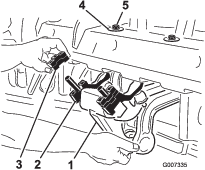
-
Assemble the damper assembly to the coring head frame again. Ensure that the D washer is installed against the coring head frame as shown in Figure 26. Secure the 2 locknuts.
To see the effects of this adjustment, adjust only 3 to 4 assemblies to compare the original position and the new position on a trial pass. When satisfactory results are achieved, move the remaining assemblies to the same height as the desired arms.
Operating Tips
Warning
Adjusting or repairing the machine while the traction unit is running may result in an accident and severe injury or death
-
Before leaving the operator’s seat, disengaging the PTO drive, engaging the parking brake, shutting off the engine, and remove the key.
-
Before repairing the machine, lower it onto the storage stands or appropriate blocking.
-
Ensure that all safety devices are secured in proper place before resuming operation.
-
Engage the PTO at low engine speed. Increase engine speed to achieve PTO speed of 540 rpm (maximum) and the lower machine. Operate at engine at a speed that the machine runs most smoothly.
Note: Changing engine/PTO speed in a particular traction unit gear (or fixed hydrostatic pedal position on a traction unit with a hydrostatic transmission) does not change hole spacing.
-
Make very gradual turns when aerating. Never make sharp turns with the machine lowered. Plan your aeration path before lowering the machine.
-
If the operating load slows the engine when aerating the machine on hard ground or going uphill, raise the machine slightly until the engine regains speed, then lower the machine again.
-
Do not aerate if the ground is too hard or dry. Best results are obtained after a rain or when turf has been watered the previous day.
Note: If the roller rides up off the ground while aerating, the ground is too hard to achieve the desired depth; reduce the aeration depth until the roller contacts the ground during operation.
-
Raise the machine penetration if the ground is hard packed. Clean up cores and aerate at deeper penetration, preferably after watering.
-
The ProCore 864 is offset to the right side of the traction unit to allow aerating without driving over the cores with the tires. Whenever possible, aerate with the longer offset towards the previous aeration pass.
-
Always check/adjust the top link whenever you change the aeration depth. The front of the machine should be vertical.
-
Look backward frequently to ensure that the machine is operating properly, and alignment is maintained with previous passes.
-
Always clear the area of all damaged machine parts, such as broken tines, etc., to prevent them from being picked up and thrown by mowers or other turf maintenance equipment.
-
Replace broken tines, and inspect and correct damage to those still usable. Repair any other machine damage before commencing operation.
After Operation
After Operation Safety
General Safety
-
Park the machine on a level surface; engage the parking brake; shut off the engine; remove the key; and wait for all movement to stop before leaving the machine.
-
Keep all parts of the machine in good working condition and all hardware tightened.
-
Replace all worn, damaged, or missing decals.
Transporting the Machine
To begin transport operation, raise the machine and disengage the PTO. To avoid loss of control, traverse steep inclines slowly, approach rough areas at reduced speed and cross severe undulations carefully.
Important: Do not exceed transport speeds of 24 km/h (15 mph).
Cleaning the Machine
Important: Do not use brackish or reclaimed water to clean the machine.
-
After daily use, thoroughly wash the machine with a garden hose without a nozzle, to avoid contamination and seal and bearing damage due to excessive water pressure.
Note: Use a brush to help remove thick layered, dried, or compacted dirt and debris.
-
Use mild detergent to clean the covers.
-
Inspect for machine damage, leaking oil, and component and tine wear.
-
After cleaning the machine, grease all drive lines and roller bearings; refer to Greasing the Bearings and Bushings.
-
Spray a light oil mist on the coring head bearings (crank and damper links).
-
Remove, clean, and oil the tines.
Maintenance
Recommended Maintenance Schedule(s)
| Maintenance Service Interval | Maintenance Procedure |
|---|---|
| After the first 8 hours |
|
| Before each use or daily |
|
| After each use |
|
| Every 50 hours |
|
| Every 100 hours |
|
| Every 250 hours |
|
| Every 500 hours |
|
| Before storage |
|
| Yearly |
|
Maintenance Safety
-
Before adjusting, cleaning, servicing, or leaving the machine, do the following:
-
Position the machine on a level surface.
-
Move the throttle switch to the low-idle position.
-
Disengage the PTO.
-
Ensure that the traction is in neutral.
-
Engage the parking brake.
-
Shut off the engine of the traction unit and remove the key.
-
Wait for all moving parts to stop.
-
Allow machine components to cool before performing maintenance.
-
-
Perform only those maintenance instructions described in this manual. If major repairs are ever needed or assistance is desired, contact an authorized Toro distributor.
-
Ensure that the machine is in safe operating condition by keeping nuts, bolts, and screws tight.
-
If possible, do not perform maintenance while the engine is running. Keep away from moving parts.
-
Do not check or adjust the chain tension when the traction unit engine is running.
-
Carefully release pressure from components with stored energy.
-
Support the machine with blocks or storage stands when working beneath it. Never rely on the hydraulic system to support the machine.
-
Check the tine mounting bolts daily to be sure that they are tightened to specification.
-
Ensure that all guards are installed and the hood is secured shut after maintaining or adjusting the machine.
-
To ensure safe, optimal performance of the machine, use only genuine Toro replacement parts. Replacement parts made by other manufacturers could be dangerous, and such use could void the product warranty.
Jacking the Machine
Caution
If the machine is not properly supported by blocks or jack stands, the machine may move or fall, which may result in personal injury.
-
Ensure that the machine is parked on a solid, level surface such as a concrete floor. Always chock the traction unit tires.
-
Prior to raising the machine, remove any attachments that may interfere with the safe and proper raising of the machine.
-
When changing attachments or performing other service, use correct blocks, hoists, or jacks.
-
Use jack stands or solid wood blocks to support the raised machine.
Note: If available, use a hoist to lift the rear of the machine. Use the eyelets in the coring head bearing housings as hoist attachment points (Figure 27)
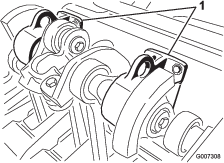
Greasing the Bearings and Bushings
| Maintenance Service Interval | Maintenance Procedure |
|---|---|
| Every 50 hours |
|
The main working bearings of the machine are sealed for life and require no maintenance or lubrication. This drastically reduces the maintenance required and eliminates the risk of grease or oil being dropped onto the turf.
There are grease fittings that must be lubricated with an SAE multi-purpose, high-temperature grease with high-pressure (EP) performance or SAE multi-purpose lithium-based grease.
Grease the machine at the following locations:
PTO driveshaft (3) (Figure 28)
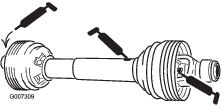
Roller bearings (ProCore 864: 2; ProCore 1298: 4) (Figure 29)
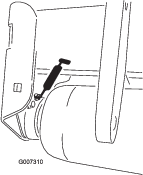
Driveshaft bearings (ProCore 864:1; ProCore 1298: 2) (Figure 30)
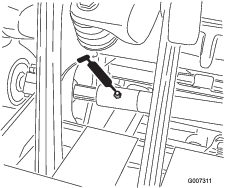
Important: Bearings rarely fail from defects in materials or workmanship. The most common reason for failure is moisture and contamination working its way past the protective seals. Bearings that are greased rely upon regular maintenance to purge harmful debris from the bearing area. Sealed bearings rely on an initial fill of special grease and a robust integral seal to keep contaminants and moisture out of the rolling elements.
The sealed bearings require no lubrication or short term maintenance. Use of sealed bearings minimizes routine service and reduces the potential turf damage from grease contamination. Inspect of bearing condition and seal integrity periodically to avoid downtime. Inspect the sealed bearings seasonally and replaced them if they are damaged or worn. Check that the bearings do not produce high heat, emit noise, vibrate excessively, or weep rust; the bearings should operate smoothly.
Due to the operating conditions these bearing/seal packages are subject to (i.e. sand, turf chemicals, water, impacts, etc.) they are considered normal wear items. Bearings that fail due to other than defects in materials or workmanship are typically not covered under warranty.
Note: Bearing life can be negatively affected by improper washing procedures. Do not wash the unit when it is still hot and avoid directing high-pressure or high-volume spray at the bearings.New bearings commonly purge some grease out of the seals on a new machine. This purged grease turns black in color due to collection of debris and not due to excessive heat. Wipe this excess grease from the seals after the initial 8 hours. The area around the seal lip may always appear wet. This is not detrimental to bearing life, but keeps the seal lip lubricated.Replace the coring head bearing every of 500 hours. A bearing service kit that covers the complete coring head is available from your distributor.
Checking the Gearbox Lubrication
| Maintenance Service Interval | Maintenance Procedure |
|---|---|
| Every 100 hours |
|
The gearbox is filled with 80W-90 gear oil or equivalent. Allow the gearbox to cool before checking the lubrication.
-
Clean debris from the fill plug and check the plug to avoid contamination.
-
Remove the check plug from the gearbox (Figure 31).
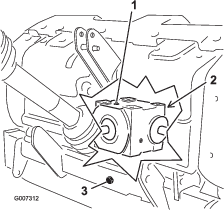
-
Make sure that the oil level is up to the bottom of the check plug hole in gearbox (Figure 31).
-
If the oil level is low, remove the fill plug from the gearbox and add oil as required.
-
Install the plugs.
Changing the Gearbox Lubrication
| Maintenance Service Interval | Maintenance Procedure |
|---|---|
| After the first 8 hours |
|
| Every 250 hours |
|
The gearbox is filled with 80W-90 gear oil or equivalent.
-
Clean debris from the fill plug and the drain cap to avoid contamination (Figure 31).
-
Remove the fill plug to relieve air draw.
-
Position a drain pan under the drain tube and remove the drain cap.
Note: The high viscosity of cool oil extends the drain time (approximately 30 minutes).
-
After oil is completely drained, install the drain cap.
-
Fill the gearbox with 1650 ml (56 fl oz) of high quality 80W-90 gear lube.
-
Install the fill plug.
-
Check the oil level.
Checking the Coring Head Fastener Torque
| Maintenance Service Interval | Maintenance Procedure |
|---|---|
| After the first 8 hours |
|
| Every 250 hours |
|
After the initial 8 hours of use, check the coring head fasteners to ensure that proper torque is maintained. Fastener torque requirements are listed on the reference service decal below and located on the coring head.

Inspecting the Belts
| Maintenance Service Interval | Maintenance Procedure |
|---|---|
| Yearly |
|
The drive belt(s) on the machine are durable. However, the normal exposure to UV radiation, ozone or incidental exposure to chemicals can deteriorate the rubber compounding over time and lead to premature wear or material loss (i.e. chunking).
Annual belt inspection is highly recommended for signs of wear, excessive cushion cracks, or large embedded debris with replacement when needed.
Adjusting the Belt Tension
| Maintenance Service Interval | Maintenance Procedure |
|---|---|
| Before each use or daily |
|
Make sure that the belt is properly tensioned to ensure correct operation of the machine and to prevent unnecessary wear.
-
Check for proper belt tension by compressing idler spring to a length of 146 mm (5-3/4 inches); refer to Figure 33.

-
Adjust the belt tension as follows:
-
Remove the rear coring head cover (Figure 34).
-
Remove the pulley shield mounting bolts and remove the shield (Figure 34).
-
Loosen the locknut securing the spring retainer (Figure 35).
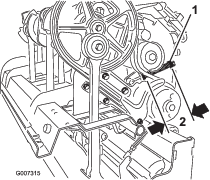
-
Adjust the spring retainer to attain required compressed spring length (Figure 35).
-
Tighten the locknut against the spring retainer to lock the adjustment.
-
Install the pulley shield and the coring head cover.
-
Replacing the Drive Belt
Note: You do not need to remove the outside stomper arm to replace the drive belt.
Removing the Belt
-
Remove the rear coring head cover (Figure 36).

-
Remove the pulley shield mounting bolts and remove the shield (Figure 36).
-
Remove the fasteners securing the dirt shield and the lower belt shield (Figure 37). Remove the dirt shield and the lower belt shield.
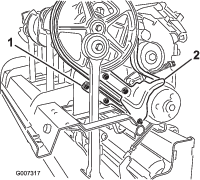
-
To release the idler spring tension, loosen the locknut securing the spring retainer (Figure 38) and rotate the spring retainer.
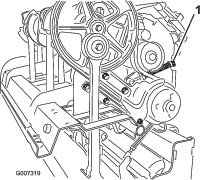
Caution
Springs are under tension, use caution when adjusting or removing.
-
Loosen and remove the 2 locknuts and washers securing the rotalink damper for the #1 stomper arm (Figure 39).
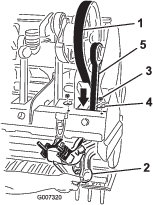
-
Lower the rotalink damper from the coring head frame.
-
Route the drive belt down through the coring head frame and around the lower end of the #1 stomper arm (Figure 39).
Installing the Belt
-
Route the new drive belt around the lower end of the #1 stomper arm and up through the coring head frame.
-
Position the drive belt onto the crank pulley, under the idler assembly and over the drive pulley.
-
Raise the rotalink damper for the #1 stomper arm to coring head frame. Ensure that the damper spacers are installed in the same position as in removal.
-
Secure the rotalink damper to the coring head with the 2 washers and locknuts previously removed.
-
Install and adjust the belt idler pulley and adjust it to the appropriate tension.
-
Install the dirt shield and the lower belt shield. Adjust the lower shield to ensure clearance with the belt.
-
Install the pulley and the coring head covers.
Adjusting the Side Shield
The coring head side shields should be adjusted so that the bottom rides between 25 to 38 mm (1 to 1-1/2 inches) from the turf while aerating.
-
Loosen the bolts and nuts securing the side shield to frame (Figure 40).
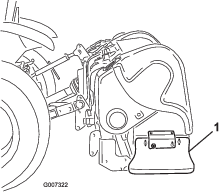
-
Adjust the shield up or down and tighten the nuts.
Replacing the Turf Guards
All turf guards (Figure 41) should be replaced if broken or worn to less than 1/4 inch thickness. Broken turf guards can catch and tear turf, creating undesirable damage.
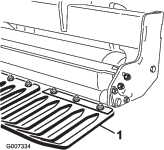
Coring Head Timing
The unitized coring head design of the machine provides industry-leading smooth operation while taking out the guesswork of timing.
ProCore 864 (Figure 42)
Each pair of crank arms joined through a bearing housing are timed 180 degrees apart (i.e. arm positions 1-2, 3-4, 5-6, 7-8). The adjacent pairs are all set with the same timing whereas the later pair lags by 120 degrees. The same pair of coupling castings are used between all adjacent pairs (i.e. coupling positions 2-3, 4-5, 6-7). To further reduce operating vibration, 2 counterweights are added at the #1 position on the pulley and the #8 position.
Note: The numbers cast into the crank arms do not align with the raised indicator mark on the bearing housings for the ProCore 864.
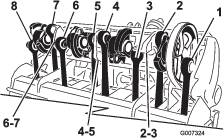
ProCore 1298 (Figure 43)
This unit is comprised of 2 independent coring heads with 6 arms each. The timing of either coring head is not dependent on the adjacent coring head. The timing marks are easily identified by the numbers cast into the crank arm castings and the raised locator on the bearing housings. The #1 arm always starts with the drive pulley.
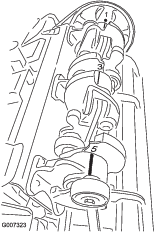
Removing the Machine from the Traction Unit
Important: Refer to the PTO driveshaft owner’s manual for additional operating and safety information.
Note: You can store the machine in the storage stand on the original shipping pallet.
Preparing the Machine and Traction Unit
Park the traction unit and machine on a level surface, disengage the PTO, engage the parking brake, shut off the engine, remove the key, and wait for all moving parts to stop before leaving the operator's seat.
Assembling the Machine to the Storage Stand
-
Assemble the pin of the storage stand through the holes in the stand bracket of the hitch frame (Figure 44).

-
Secure the storage stand pin to the stand bracket with the 2 lynch pins (Figure 44).
-
Repeat steps 1 and 2 at the other side of the machine.
-
Slowly lower the machine until the storage stands contact the ground.
Assembling the Machine to the Storage Stand
Note: The storage stand weighs approximately 85 kg (187 lb).
-
Align the support plates of the storage stand with the stand bracket on the hitch frame of the machine (Figure 45)
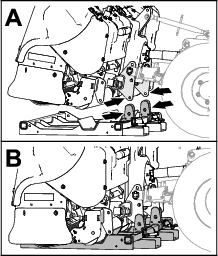
-
Lower the machine into the storage stand until the holes in the stand align with the holes in the stand bracket of the hitch (Figure 45).
-
Secure the storage stand to the machine with the 2 storage-stand pins and 2 hairpins (Figure 46).
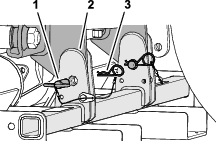
-
Slowly lower the machine until it contacts the storage stand.
Disconnecting the Machine from the Traction Unit
-
Remove the 2 lynch pins and slide the lower link arms off the hitch pins of the machine (Figure 47).
Retain the lynch pins with the machine.
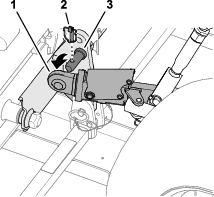
-
Loosen the locking nut (Figure 48) and rotate the upper adjusting link to release the tension between the machine and the traction unit.
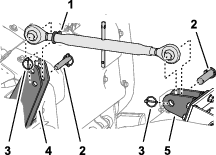
-
Remove the lynch pin and the link pin that secures the upper adjusting link to the upper hitch plates of the machine (Figure 48).
-
Remove the lynch pin and the link pin that secures the upper adjusting link to the link bracket of the traction unit (Figure 48).
Note: Retain the lynch pin and the top link pin with the machine.
-
Disconnect the safety shield chain (Figure 49) from the traction unit PTO (CE only).
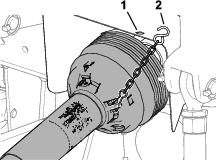
-
Pull back on the lock collar to disconnect the PTO driveshaft from the PTO output shaft on the traction unit.
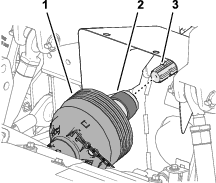
-
Slide the PTO driveshaft back and remove it from the traction unit.
-
Use the safety shield chain to support the PTO driveshaft by assembling the chain between the PTO shield and the machine (Figure 51).
Note: Supporting the PTO driveshaft prevents it from contacting the ground.
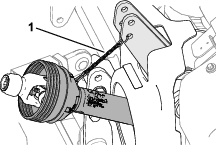
Storage
Storage Safety
-
Before adjusting, cleaning, storing, or repairing the machine, park the it on a level surface; engage the parking brake of the traction unit; shut off the engine; remove the key; and wait for all movement to stop before leaving the traction unit.
-
Store the machine on the storage stands positioned on a firm, level surface so that it does not sink or tip over.
-
Store the machine away from areas of human activity.
-
Do not allow children to play on or around the stored machine.
Storing the Machine
At the end of an aerating season or when the machine is stored for a long period, do out the following procedure:
-
Clean off any dirt or grease that may have accumulated on the machine or any of the moving parts.
-
Remove and clean out the tines. Coat the tines with oil to prevent rusting during storage.
-
Open the hood and clean out the inside of the machine.
-
Lubricate all grease fittings.
-
Store the machine on the provided storage stands on a hard, dry surface.
-
Support the PTO driveshaft in the stored position with the tether to prevent damage, or remove the PTO and store it under the hood to minimize corrosion.
-
Paint the roller and touch up any other scratches on the painted surfaces.
-
Replace any missing or damaged decals.
-
Store the machine inside a dry, secure building. Inside storage reduces maintenance, gives a longer working life, and increases the residual value of the machine. If inside storage is not available, cover the machine with a heavy sheet or tarpaulin and secure it tightly.
